TOON VERHOEF | LOST AND FOUND
Disappearing and Appearing, Hesitation, Disintegration, Disruption. When Toon Verhoef has to describe his work, terms that read like a poem follow. Swoon, Chimère, Restless and Laconic are a few more. Piece by piece starting points for looking at his paintings, words that attach themselves to the canvas like barbs or move slowly around it like a swarm and yet, added up, never explain everything.
The search for the unknown is perhaps the most important underlying motive for Verhoef. And in this quest he also takes the viewer with him. Indeed, at first you wonder what exactly you are looking at, but as soon as you try to fathom it, the painting slowly but surely draws you in.
Verhoef's large and abstract-looking paintings are full of contradictions. There are forms that float, clash or adopt a firm stance, lines that seem to encircle spaces while there is no evidence of space or depth. In his compositions Verhoef plays with mirroring, repetition, reversal and overlapping. Always in perfect balance, but just barely, as if it all could fall over the edge at any moment. The question of exactly where those forms come from has then already been abandoned. The canvas is a new context in which meaning dissolves and everything revolves around creating an exciting and perfect balance that he simultaneously constantly disrupts.
The fact that we can keep on looking at them without comprehending them also has to do with Verhoef's way of subtly incorporating multiple layers into the painting. Not only does he paint directly onto the linen, but also onto the front and back sides of a thin and transparent layer of binding agent which he later affixes, like a collage to the canvas. This gives rise to a literally stratified canvas in which – entirely in accordance with the legacy of minimalism – he suggests no illusion whatsoever, but nonetheless allows space to enter the image undetected.
This again applies to his recent square paintings.
Toon Verhoef: ‘The square format suggests stability, tranquillity, neutrality. Not so much things I strive for in my work. The first sketches for these paintings came about in response to an almost square painting from the early 1970s. In it, I drew large arcs like a quarter circle, from the corners of the canvas, but because one is missing each time - there is a sense of instability, imperfection and detachment. That restlessness and shaky feeling now play a role in all six paintings. The floating rectangles disturb the stability of the square while the void in the middle is uncomfortably filled with searching and clashing segments. Thus, an impossible balance between stasis and movement forms. Static and dynamic at the same time.
Esther Darley
Opening Thursday May 30, 4 – 8 pm
Artist Talk, the same day 5 - 6.30 pm
Opening hours during Amsterdam Art Week
Friday May 31 : 12- 6 pm
Saturday June 1 : 12-6 pm
Sunday June 2 : 12-5 pm
